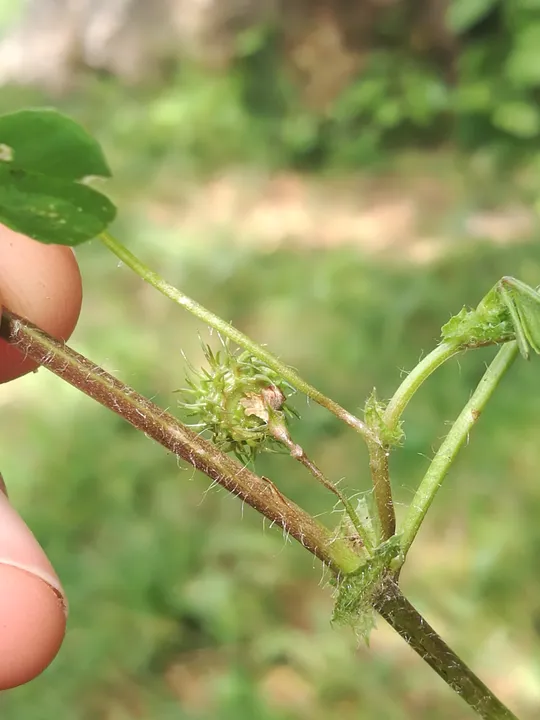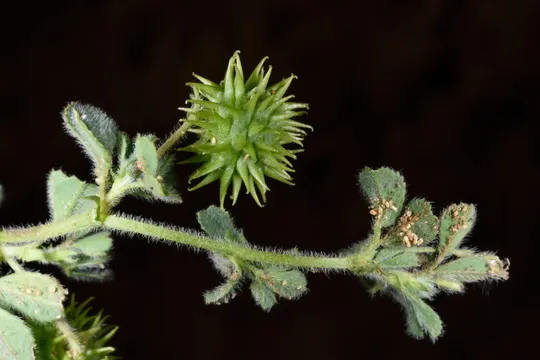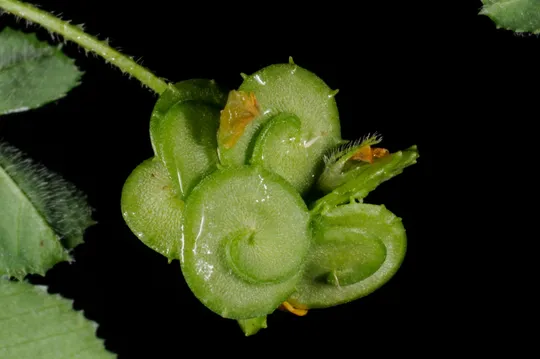Cytisopsis pseudocytisus
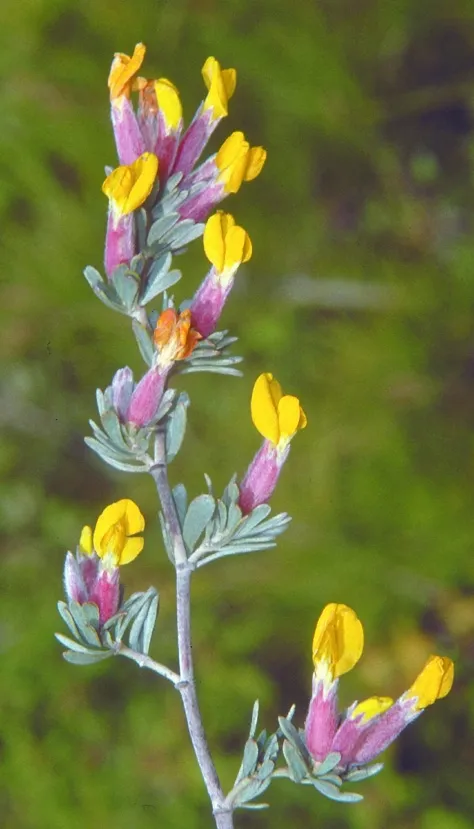
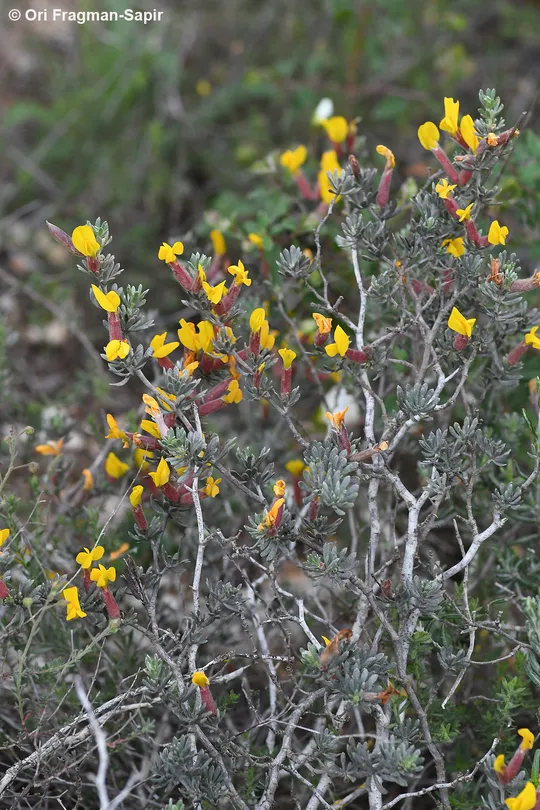
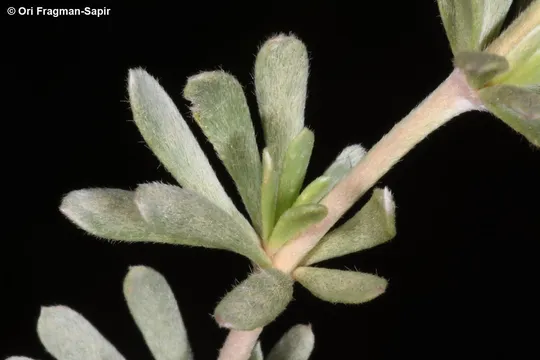

Cytisopsis pseudocytisus is a small branching shrub, 15-30 cm high and up to 40 cm in diameter. It has trifoliate silvery leaves and its flowers and fruits are similar to those of the genus Lotus. Unlike Lotus species in Israel, that have three leaflets and two leaflet-like stipules, C. pseudocytisus has 5-7 silvery leaflets in a palmate arrangement. The flowers sit between the leaves in groups of 1-3. The calyx is very long (1.3 cm) and hairy-velvety. The large flower has yellow petals with a reddish tint. C. pseudocytisus blooms in spring, from the second half of March to April.
Cytisopsis
pseudocytisus is
known in Israel only from the Carmel, with the exception of three
unusual locations in the upper Galilee. In the Carmel, it is very
common, growing on marl and chalk along with Pinus halepensis and Genista
fasselata. Cytisopsis grows many locations on the Carmel in: Ahuza,
the University, the Hareva Quarry, Mount Kelah, HaKtalavim Lot, Wadi Sfunim,
Mount Alon, Ramat Bet Oren, Mount Arkan, and in the area of upper Wadi Nesher,
on Hraybeh chalk.
Until in 1990, the
species was considered exclusive to the Carmel (Shmida 1983). Shuka Ravak collected
it near Adamit; that same year, it was also collected in Wadi Eshhar near Eshhar
Ruins. Aviva Rabinowitz found it in 1997 in the Wadi Sha’al Stream. At the last
two locations, 25-50 plants were recorded; near Adamit only 5 specimens were
found.
The species was
collected once at the beginning of the 20th century in the Sharon,
near Pardes Hanna, (the exact location was not specified). Based on this
record, the Flora Palaestina records its distribution area as "the Sharon",
although the location would be more correctly described as on the edge of the
Carmel.
Grows in bathas or pine
forests, in open habitats, on chalk rock or in rendzina and marl soils.
the
genus Cytisopsis has only two species, both found in
the eastern Mediterranean Sea basin. It could be considered as a parent group
of the genus Lotus, as it is characterized by two “ancient” traits: 5-7
leaflets, and a woody life form. The entire group is characteristic of the
Mediterranean biogeographic region, and it is interesting that it has an
ancient branch of perennial Lotus species in California.
Cytisopsis belongs to a special group of
Mediterranean species whose distribution in Israel is limited to the Carmel
(Shmida 1983). This group also includes – Romulea phoenicia, Genista
fasselata, Verbascum levanticum and Allium tardiflorum.
Due to the uniqueness of this biogeographic group, some scientists have
recommended prioritizing the preservation of Cytisopsis pseudocytisus.
·
The
entire Israeli population is concentrated in almost only in one region – in the
Carmel, on marl, near pine forests, and it is threatened by wildfires. In
recent years, construction and soil exposure near the Druze villages in the
Carmel has increased, leading to the extinction or weakening of many
populations. Developers find it is much easier to level chalk and marl areas
for construction, which regrettably is the preferred habitat of the Cytisopsis.
·
Cytisopsis was placed on the red species list although the sum
total of its red parameters (see “The Red Table”) of 5 is under the threshold
value of red species. However, if connectivity is also considered, when the
species locations are geographically in one segment (or very close) another
unit is added to the red value. In this case, the population faces greater
danger of extinction from epidemics, fire or other hazards, which spread to
nearby areas.
Two populations, Hareva Quarry and the thicket south of Haifa University)
should be selected for demographic monitoring, including the effect of shade on
the vigor of the plants. Ten additional locations should be managed by leaving
the area open and partially shaded. Natural exposed chalk areas that have a
20-70% tree cover should be protected.
Cytisopsis pseudocytisus grows in the eastern
Mediterranean: Southern Turkey, Syria, Lebanon and Israel. It is absent from Cyprus.
A woody dwarf shrub, unique to Israel and found almost exclusively on the
Carmel. Grows on chalk and marl, where construction and soil exposure threaten its
populations. The species grows in many locations on the Carmel and a few in the
upper Galilee, but is absent from other Mediterranean regions in Israel.
Current Occupancy Map
| 1000 squre meter pixel | 5000 squre meter pixel | 10000 squre meter pixel | |
|---|---|---|---|
| number of observations | 0 | 0 | 0 |
| in total pixels | 0 | 0 | 0 |
| Family | Fabaceae |
| Classification | On the near threatened species list |
| Ecosystem | Mediterranean |
| Chorotype | Mediterranean |
| Conservation Site | Hareva Quarries |
| Rarity |
1
2
6
|
|---|---|
| Vulnerability |
0
1
4
|
| Attractiveness |
0
0
4
|
| Endemism |
0
0
4
|
| Red number |
1
2.6
10
|
| Peripherality | N |
| IUCN category | DD EW EX LC CR EN VU NT |
| Threat Definition according to the red book | Near threatened |
 Based on:
Based on:

